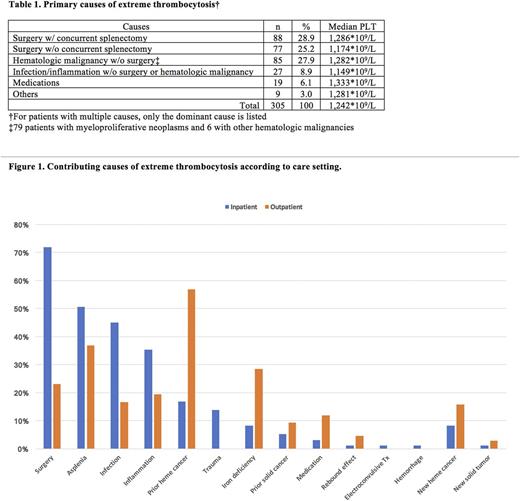Abstract
Introduction
Extreme thrombocytosis (EXT) is defined as platelet count >1,000x109/L. The objectives of our study were: 1) to describe the causes of EXT in both the inpatient and outpatient settings, and 2) to determine the frequency of occult malignancy as a cause of EXT.
Methods
We conducted a retrospective chart review of adult patients (age≥18 years) with EXT seen at Mayo Clinic from 2011-2016. We included patients who had ≥2 platelet counts >1,000x109/L within 30 days. Patients who declined a bone marrow biopsy were excluded. For each patient, we determined potential contributing causes of EXT and identified the most likely dominant cause.
Results
We identified 44,490 patients with thrombocytosis, of which 645 patients (1.4%) had EXT. We excluded 340 patients including 337 patients who did not meet the criteria for two readings of EXT, and 3 who did not undergo bone marrow biopsy. The remaining 305 patients included 109 outpatients (35.7%) and 196 inpatients (64.3%). The median age was 57 (range: 18-95 years) and the majority were females (52.1%). The median peak platelet count was 1,242x109/L (1,009x109/L -3,209 x109/L), and the median duration of EXT was 6 days (range: 2-389 days).
The causes of EXT were as follows: 31.1% of all the patients had a previous or a new diagnosis of hematologic cancer, predominately myeloproliferative neoplasms; the remaining 68.9% had either recent surgeries or a variety of non-malignant medical conditions. Because 79.3% of patients had more than one identifiable causes of EXT, we assigned the dominant cause based on (1) the temporal association between the platelet trend and the factor and (2) the extent of platelet increase attributed to the factor. The dominant causes of EXT are shown in the Table 1. The majority (82.0%) of the EXT occurred in the setting of splenectomy, other surgeries, or hematologic cancers. In the absence of surgery or hematologic cancer, infection/inflammation was an infrequent cause of EXT (8.9%). While iron deficiency was relatively common (15.4%), it was never identified as the sole cause of EXT, and rarely (0.3%) as the dominant cause. In 2.3% of the patients, EXT was associated with rebound thrombocytosis after chemotherapy. The contributing causes of EXT varied according to the care setting as depicted in the Figure 1. Surgery and infection were the dominant causes in the inpatient setting. In contrast, hematologic cancers and iron deficiency were the major causes in the outpatient setting.
During the evaluation of EXT, 38 (12.5%) patients were diagnosed with new malignancies. Of these, 33 (86.8%) were hematologic cancers (30 myeloproliferative neoplasms, 2 diffuse large B-cell lymphoma and 1 acute myeloid leukemia). In 5 patients, solid cancers were discovered (2 colon cancers, 1 ovarian cancer, 1 gastric cancer and 1 squamous cell carcinoma of the mandible). Outpatients were twice as likely to be diagnosed with new cancers as inpatients (18.4% vs 9.2%).
Conclusions
In our study, EXT was often multifactorial. Contributing factors varied by care setting. The most common causes were surgery (including splenectomy) in inpatients, and hematologic cancers in outpatients. EXT was a presenting manifestation of occult malignancy in over 10% of cases.
No relevant conflicts of interest to declare.
Author notes
Asterisk with author names denotes non-ASH members.


This feature is available to Subscribers Only
Sign In or Create an Account Close Modal